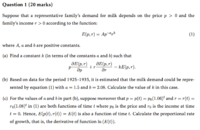Hey guys I'm in a lot of strife with this question. I've solved part a and b but am really stuck on c because I don't really understand logarithms well or how to differentiate them. This is what I have so far but I think I might be tackling it the wrong way. Can someone please tell me if there is a better way of if my way is ok how to go about the next step because I have no idea. Thanks heaps




Last edited by a moderator:
